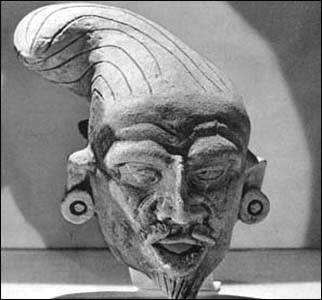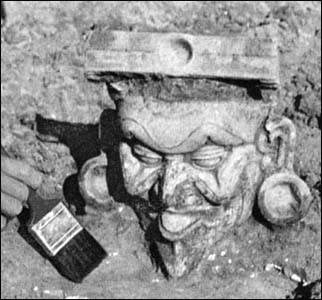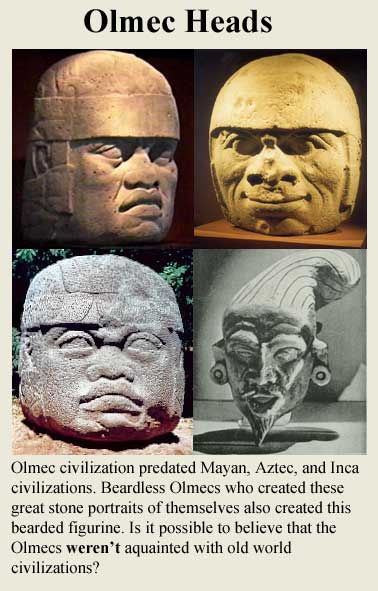

These Semitic looking figure heads are were found in Mexico and are usually attributed to the Olmec culture that pre-dated the Aztecs. Note their beards, absent in natives of that land, and the floppy hat which is typical of Phoenician sailors.
Posted on 07/10/2011 6:57:49 PM PDT by SunkenCiv
Archaeologists from the Portuguese Association of Archeological Research (APIA) believe to have found in the Azores a significant number of Carthaginian temples, from the fourth century BC, dedicated to the goddess Tanit.
The new archaeological sites were found in Monte Brasil, Angra Heroismo, Terceira island.
According to APIA archaeologists Nuno Ribeiro and Anabela Joaquinito, "More than five hypogea type monuments (tombs excavated in rocks) and at least three 'sanctuaries' proto-historic, carved into the rock, were found."
A monument located at "Monte do Facho" shows inbuilt sink shaped carvings linked to water conduits for libations. "There are 'chairs' carved into the rock, a ceremonial tank covered by vegetation, and dozens of post holes indicating the existence of a shelter over the area," they said.
The APIA's researchers said, "The temples carved inside the hypogea structures are large and very well preserved and were drawn almost in a triangular shape."
They said, "In the first temple there are four sinks linked to conduits to collect fresh water associated with ritual libations, probably for sacrifices purposes."
The second and third shrines are located in the area of the Forte de São Diogo and were discovered in late June.
Recently, traces of Sunni inscriptions were discovered on São Miguel Terceira island, by APIA archeologist Nuno Ribeiro. Previously, a number of Carthaginian and Greek coins were found on the island of Corvo and dozens of pre-Christian hypogea were uncovered on the islands of Terceira and Corvo. Similar findings were also reported on the islands of Santa Maria and Flores.
Based on their findings, researchers now believe it is possible to establish that human presence in the Azores precedes the Portuguese occupation of the islands in the fifteen century.
(Excerpt) Read more at portuguese-american-journal.com ...
We had to lay our M-16s on the floor of the bus because the US could show no display of force back in the days of Jimmy Carter's Air Force. I imagine it is the same now in BO's AF
Hi blam! What I am trying to say is, that Sao Miguel aqueduct would harldy have been built by the Portugese after their settlement of the island in the 15 century, would it?
All I could ever find on that aqueduct is that it is ‘very ancient’ but not a word about when it was constructed, nor by whom.
The Phoenicians are the ancestors of the Lebanese. For some reason, my ancestors were incredible traders, and traveled incredible distances to trade. They were the leaders of “global trade” of their time.
The Phoenicians are the ancestors of the Lebanese. For some reason, my ancestors were incredible traders, and traveled incredible distances to trade. They were the leaders of “global trade” of their time.
The region of San Miguel was the cradle of colonization Biguaçu, whose official launch was in 1748 with the arrival of the first wave of Azorean immigrants. Due to the opening and paving of the BR 101 region was far from lost, destroyed or removed, so that the historic buildings, few remained. The remaining however, make a single copy in the state, such as:
OLD AQUEDUCT OF SAN MIGUEL
Or the rest of the aqueduct used to supply drinking water from boats and ships in the region, and on their way to or returning from the region of Silver (Pref.Mun.deBiguaçu).
Translated from Portuguese.


These Semitic looking figure heads are were found in Mexico and are usually attributed to the Olmec culture that pre-dated the Aztecs. Note their beards, absent in natives of that land, and the floppy hat which is typical of Phoenician sailors.
www.Trails-Azores.com PR25SMI - Fonte do Sapateiro
This small linear trail begins in the parish of Ginetes, opposite the Parish Church of São Sebastião (built between 1603 and 1605, to replace an earlier church), and is comprised mainly of footpaths all the way to the crater ridge in Sete Cidades. Begin the trail by walking through the village of Ginetes. The path then follows a watercourse, at times traversing the bed of the stream. On the way one can see various aspects of rural life, such as small family orchards and animals grazing. The main point of interest on this trail is the Sapateiro Spring, a spring of clear water that used to supply the local population. To reach the spring, you have tol go under the old aqueduct, which dates from 1778, and which used to channel the water. Stone water troughs once used for washing clothes can also be seen here. The trail then climbs up to a point where you can enjoy a view of the entire coastline south of Ginetes, including the hill which gave its name to the parish (Ginetes means “thoroughbred horses”). The historian Gaspar Frutuoso (1522-1591) believed the name was given to the parish because it was “sheltered from the winds on the lower, coastal side, by the Ginetes Peak, which was so named because it was shaped like a saddle in the middle, and also because (as others say) small, thoroughbred horses were raised there, on the upper side. The trail continues as far as the ridge of the crater of Sete Cidades via a dirt track. When you reach the top, you come to Trail PR-7-SMI and can either turn right and go to the Vista do Rei vantage point or turn left and walk to the parish of Sete Cidades (whichever way you choose, it will take about 1 hour to complete this 4 kilometre trail).
I was under the impression it might have been much older. Thanks
Thanks! It may be Portuguese-era in origin?
Thanks for all those replies, great that you got to visit the cave.
Olmec statues are usually very rounded figures and as you notes without facial hair. Not sure how those figures get classified as Olmec.
Also, I lost the picture of the Olmec statue that looked just like a Jewish Rabi...a Jewish FReeper told me that just put (what are those Jewish caps called?) a cap on him and he looked like his Rabi.

Nordic Origins
Detail of the carved portrait nicknamed "Uncle Sam" by researchersAccording to Michael Coe, explorer and cultural diffusionist Thor Heyerdahl claimed at least some of the Olmec leadership had Nordic ancestry, a view at least partly inspired by the bearded figure, often referred to as "Uncle Sam",[41] carved into La Venta Stela 3, whose apparent aquiline nose has been cited as possible evidence for ancient visitors to the Americas from the Old World.
Apparently they were classified as such according to where they were found, In Mexico.
The Izapa Stela 5 suggests their arrival...maybe?
Looks that way...probably built with slave-labour?

Asian, negroid, semetic...and Vikings, all found their way to Mexico? It certainly looks that way...


Doubt that Christopher Columbus's sailors were the first Old World inhabitants that made contact with American Indians is almost as old as the Spanish Admiral's discoveries. In the art and folklore of American's autochthonous towns there are several indications which make us think that some sporadic contacts occurred between civilizations on both sides of the Atlantic as early as the first millennium BC...
That would also account for the presence of so many different racial groups in one spot at that time.
And, they all apparently appeared there fairly suddenly...I've read.

Another unexpected face. Bearded ceramic head of pre-Columbian origin from Rio Balsas, Guerrero, Mexico. Photo: American Museum of Natural History
I spent 15 of the most miserable months of my life on Terceira. I’d prefer not to have to think about them - ever. Summer weather was nice while it lasted, the girls were pretty, but nearly all jail-bait. The rest of the time was spent trucking up one hill and down the other (Santa Rita Hill)and around the airfield....I posted a world-wide-anywhere volunteer listing to get out of there.
Disclaimer: Opinions posted on Free Republic are those of the individual posters and do not necessarily represent the opinion of Free Republic or its management. All materials posted herein are protected by copyright law and the exemption for fair use of copyrighted works.